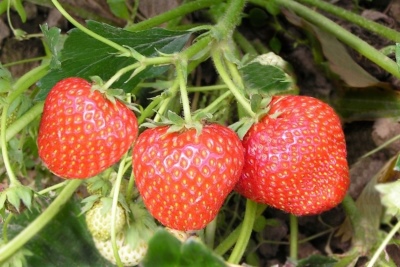
- Authors: Kokinsky strong point VSTISP, Russia
- Name synonyms: Fragaria ananassa
- Taste: sweet and sour
- The size: large
- Weight: 25-35
- Yield rate: very high
- Yield: 11.0-12.0 t / ha
- Repairability: Yes
- Ripening terms: late
- Appointment: fresh consumption, processing (juice, jam, jam, etc.)
Alpha is a strawberry variety bred by the Kokinsky stronghold of VSTISP. The variety was the result of crossing the Surprise Olympiad strawberries and Festivalnaya Chamomile. Caring for Alpha strawberries is not a problem, but some rules should be followed.
Description of the variety
Alpha bush is vigorous, medium spreading, has dense foliage. The leaves themselves are medium-sized, with crenate edges, the color is bright green. The variety is characterized by an average amount of mustache of standard length and a pinkish-green hue. The rosettes are strong and take root well.
Ripening terms
Flowering begins in mid to late July. Thus, Alpha belongs to the late ripening varieties.
Yield
The variety is characterized by a high yield, amounting to 11-12 t / ha.
Berries and their taste
The fruits are large, have a red color, their shape is oval-conical, and their weight is 25-35 g. The pulp is dense, juicy, the taste is sweet and sour. The advantage of the berries is their good transportability, which makes it possible to grow strawberries not only for private use, but also for sale. The purpose of the berries is universal: they can be consumed fresh, as well as processed into juice, jam, compote and used for other culinary purposes.
Growing features
Alpha strawberry care is not difficult. The variety is characterized by good winter hardiness and high drought resistance, therefore it is allowed to grow both in most of Russia and in the northern and mountainous regions of Scandinavia.




Site selection and soil preparation
It is recommended to plant the Alpha variety in May, for planting it is better to choose evening, morning or cloudy day.Plots where potatoes, cucumbers, and tomatoes were previously kept are best suited for planting. Places with shallow groundwater levels should be avoided.
The optimal planting scheme in a compact area is 70x35 cm. After planting, the seedlings should be well watered, 3 liters of water for each bush is enough.

Pollination
On each bush during the flowering period, many inflorescences are formed - 7-9 units each. Each inflorescence has several bisexual flowers. Thus, it is a self-fertile variety that does not require replanting of a pollinator plant.
Top dressing
Mostly Alpha needs fertilization in the spring. During this period, it is better to use superphosphates, humates or organic matter for feeding. When flowering, products with a high potassium content will be relevant. The last fertilizer is applied after harvest; as additional nutrition during this period, organo-mineral substances, infusions of bird droppings or mullein are suitable.

One of the important techniques in strawberry care is feeding. Regular fertilization guarantees a rich harvest. There are several different ways to feed strawberries, and each of them is designed for a specific period of plant development. During flowering, fruiting and after it, feeding should be different.
Frost resistance and the need for shelter
The winter resistance of the variety is quite high, but for a more comfortable maintenance, the plant should be prepared for winter. So, in the fall, damaged and old leaves should be eliminated and peat or compost should be added as mulch. It is recommended to huddle the plants a little.
When growing a crop in a cold zone with a small amount of snow, it is advisable to wrap the bushes with non-woven material, but you should refuse to cover with a film, since the plants under it can vomit.

Diseases and pests
Strawberry Alpha can be easily affected by brown and white spots, the variety is relatively resistant to gray mold. For prevention purposes, dense plantings should be avoided.
The presented variety can become a delicacy for the bronze beetle, weevil, strawberry and spider mites. The means of protection against these pests are infusions of garlic, onions, tansy. If the bush is already affected by insects, then it is worth resorting to insecticides.

Strawberries are often subject to many dangerous diseases that can seriously undermine their condition. Among the most common are powdery mildew, gray mold, brown spot, anthracnose and verticillosis. Before buying a variety, you need to inquire about its disease resistance.
Reproduction
Variety Alpha is allowed to be bred in three ways.
Seeds. This is not the most convenient method, but gardeners who are not afraid of difficulties can try seed propagation. To do this, sow the seeds in the winter, not deeply burying them in the ground. Next, cover the container with a film, and after 2-4 weeks expect the sprouts to appear.Water the shoots regularly and keep them well lit. Do not forget about complementary complex nutrition. When 4-5 leaves appear, shoots can be planted in open ground.
Mustache. With this breeding method, choose the most productive mother bushes, leave 3-5 whiskers on them and cut them off when the rosettes take root. Grow outlets in cassettes or in the open field until early August, and then replant to a permanent place.
By dividing the bush. For division, powerful bushes are chosen at the age of 3-4 years. The optimal time for this manipulation is August. Dig out the selected specimen, carefully separate it into sockets, and plant it in a new place. Such bushes require routine care and protection for the winter.



















































































